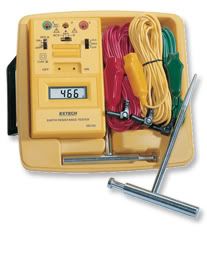brian john said:
Rexowner:
May I ask how you performed this testing?
For the Ufer, we were building two mirror-image houses
next to one another, so I was literally able to hook
my Fluke 87 to each Ufer, put it on "ohms" and got
13.0 Ohms, which I divided in half to get "about 6.5."
I realize this was quick and dirty, and quite honestly,
I am not sure how meaningful it is until I increase my
knowledge in this area. It got me curious because
I had never really had any practical way of measuring
ground resistance before.
I recently got an Extech, 382152, Earth Ground Resistance
Tester Kit:
I put the spikes 20 feet and 40 feet away, connected
the electrodes, set it in the 20 ohm range, and got
1.6 ohms during a three minute test.
I realize this may be more of a personal interest than
a practical way to make money as an electrician.
The "Soares" book seems to be the name that keeps
coming up, so that is on my list of things to read in
the future. I would be interested in any other suggestions.
I am glad you asked, because I don't find a lot of local
electricians very interested in this. Thanks.


